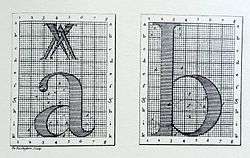Bignon Commission

The Bignon Commission (French: commission Bignon; 1693–1718) was a group directed by the French minister Colbert to examine the feasibility of compiling a description of all the arts and industrial processes used in France.[1] It was headed by Abbé Bignon, who selected the royal typographer Jacques Jaugeon, the scholar Gilles Filleau des Billettes, and Father Sébastien Truchet to assist him.[1] As part of their participation, the three were named to the Academy by King Louis XIV in 1699.[2][1] The commission reported that the project would be feasible[1] and began by examining French printing and typography, as the "art by which all others are preserved".[3] As part of the project, Jaugeon and Truchet established the first typographic point system,[4] vector fonts, the bitmap, slanted italic type,[n 1] and the Romain du Roi ("King's Roman") font,[5] which later developed into Times New Roman.
In 1710, the work continued under a new chief editor, René Antoine Ferchault de Réaumur.[2] The commission was reorganized in 1718, with other groups continuing its work.[6] The release of Diderot and D'Alembert's Encyclopedia in 1750 finally caused the Academy to finally publish a 73-volume Descriptions of the Arts and Trades but it remains generally unknown.[4]
See also
Notes
- ↑ Italic type to this point was cut separately as a similar but distinct font. The Romain du roi had no separate italic font but was italicized mathematically through deforming the axes of its bitmap.[5]
References
Citations
- 1 2 3 4 Sturdy (1995), p. 301.
- 1 2 André (1999), p. 8.
- ↑ André (1999), p. 8–9.
- 1 2 André (1999), p. 9.
- 1 2 André (1999), p. 10.
- ↑ Porchez (2004).
Bibliography
- André, Jacques; et al. (1999), "Father Truchet, the typographic point, the Romain du roi, and tilings" (PDF), TUGboat, Vol. XX, No. 1, pp. 8–14.
- Porchez, Jean François (2004), "Nationality and Type Design", Typofonderie.
- Sturdy, David J. (1995), Science and Social Status: The Members of the Académie des Sciences, 1666–1750, Woodbridge: St Edmundsbury Press for the Boydell Press, ISBN 0-85115-395-X.